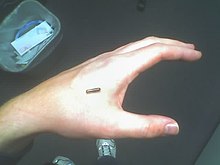Entrepreneur's RFID chip implant to open doors, start car
Thursday, March 24, 2005

Photo credit: Amal Graafstra

Photo credit: Amal Graafstra
A technology entrepreneur in northeastern Washington asked a doctor to implant an RFID chip into his hand in order to experiment with the technology. Amal Graafstra, who runs a technology company in Bellingham, WA, asked a doctor to place the chip under the skin of his left hand, and posted pictures of the procedure to the photo-sharing site, Flickr. Graafstra plans to use the chip for keyless entry to his car, home, or as a login for computer systems.
Implanting RFID chips is a relatively old technology. Professor Kevin Warwick of the University of Reading, UK implanted a 23mm RFID chip into his left arm in August 1998. It allowed him to open doors and turn on the lights in a room as he entered. Further European research in the area was recently dealt a blow when the European Group on Ethics in Science and New Technologies made a presentation to the European Union raising privacy concerns over the potential for such chips to be used to track members of the public.
In mid-2004, about 160 Mexican officials received RFID implants for security purposes, and scientists in the past have implanted themselves with such chips for research purposes. In October 2004, the U.S. Food and Drug Administration (FDA) approved the implantation of Verichip technology for medical purposes.
An implantable RFID chip is a minuscule capsule containing a microchip and an antenna, all enclosed in glass. The chip that Mr. Graafstra had implanted was 12mm long and 2mm in diameter — about the size of a grain of rice. RFID chips work by storing a unique identification number in the microchip. This number can be retrieved by a special RFID reader that is held within close proximity. Graafstra notes that his chip can be read from a distance of about 2 inches (5cm), and only provides the single identifying number.
Describing himself as a long-time tinkerer, Graafstra's comments do not show much of a hesitation to perform this process. "I like to mod things, and I guess it was only natural that it extended to my own body," he wrote in an email to Wikinews.
Graafstra appears to have been impressed by the process, too. "It was odd feeling it [the chip] being pushed under the surface of my skin... without feeling pain, I was able to really get a feel for just how utilitarian our bodies actually are and how... separate the skin layer really is from the muscle layer under it," he told Wikinews. He was able to use his hand to perform technical computer maintenance just an hour after the procedure.
RFID is a controversial technology. Privacy advocates fear that the technology might be abused by governments and used to track people. Microchip implants have been used for years for tracking lost pets.
The pictures that Graafstra posted spurred commentary in the blogosphere, with some assuming that the pictures — or the process — were faked. Graafstra denies this, and posted a short video of himself triggering the RFID reader with a swipe of his hand.
Sources
- Will Weissert (AP). "Microchips implanted in Mexican officials" — MSNBC, July 14, 2004
- Press release about FDA approval of Verichip
- "Home truths: Bionic man takes the Metal Mickey" — The Register, July 4, 2000
- Lester Haines. "EU fusses over cyberhumans" — The Register, March 17, 2005
- Professor Kevin Warwick. "Are Chip Implants Getting Under Your Skin?" — Compiler, 2003
External links
- Pictures of the implantation process
- Amal's FAQ about the implant
- Post on the popular boingboing blog



